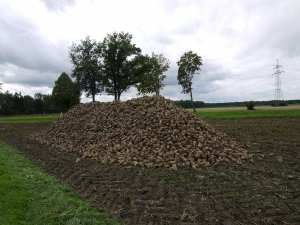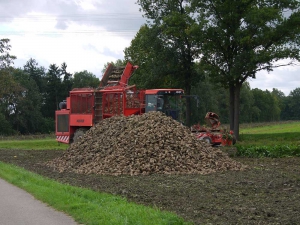I was rather disappointed by these as I was looking for a heap of potatoes, which they resembled from afar. But it’s an opportunity to point out that mangold in English is not the same as Mangold in German. Although apparently it is.
The green stuff at the centre to back right is their leaves.
Die Futterrübe (Beta vulgaris subsp. vulgaris var. crassa bzw. var. alba), auch Runkelrübe, Raahner, Rangasn, Runkel, Rummel, Rüben-Mangold, Vieh-Mangold, Burgunder-Rübe, Dickrübe, Gunkel genannt, ist eine landwirtschaftliche Kulturpflanze und gehört zur Familie der Fuchsschwanzgewächse (Amaranthaceae).
Mangelwurzel or mangold wurzel (from German Mangel/Mangold, “chard”, and Wurzel, “root”), also called mangold,[1] mangel beet,[1] field beet[2] and fodder beet, is a cultivated root vegetable derived from Beta vulgaris. Its large white, yellow or orange-yellow swollen roots were developed in the 18th century as a fodder crop for feeding livestock.
This still doesn’t answer the question why we call Swiss chard Swiss.
And if you prefer pumpkins, see Switzerland in a Nutshell 1 at Anglo-German Translations
LATER NOTE: in Just Hungry, Maki explains why Swiss chard:
Incidentally, here in Switzerland it is not called Swiss anything. In the German speaking parts it’s usually called either Krautstiele, Stielmangold or plain Mangold, and in the French speaking parts it’s just called blette. Apparently it was called Swiss chard in some English-language seed catalogs to differentiate it from French charde or chardon originally.



That’s cool how it’s in the city and out of town at the same time.
And I’m surprized you haven’t had any comments about “viewing birds with ideal equipment” yet. <;-)
You obviously read my posts more carefully than I do!